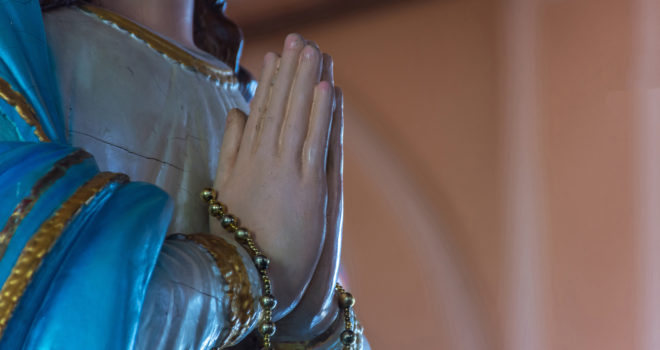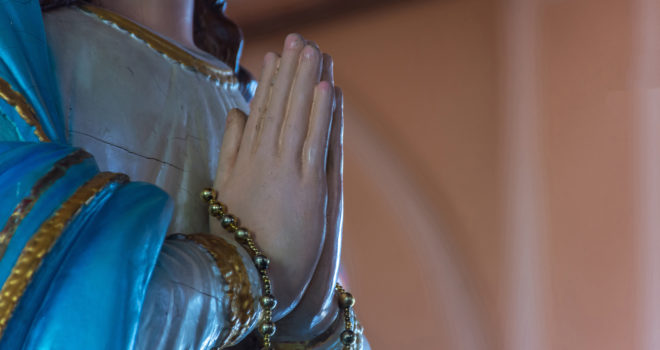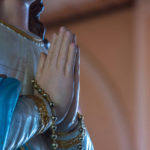When the Blessed Mother appeared in Mexico in 1531, she came to a society that greatly needed her maternal intercession. Many Spanish inhabitants were not living as faithful Catholics, Spanish government officials were unjust toward the native people, and despite the presence of missionaries, there were very few conversions among the native Mexicans. Previously, under Aztec rule, as many as 50,000 people a year were sacrificed to pagan gods, and human sacrifice still continued at the time of Our Lady’s appearance.
Early on a Saturday morning, on December 9, 1531, Juan Diego, a member of the Chichimeca tribe of native Mexicans and a Catholic convert, was walking to church to attend Mass, when he heard beautiful music which sounded like the singing of birds coming from the hill of Tepeyac. Then he heard a woman call his name. He went up to the top of the hill where he saw a beautiful woman, who looked like a native Mexican and who spoke his language. She addressed him as her son and asked where he was going. He realized she was the Blessed Mother and told her he was going to church. Our Lady then said to him: “You know for certain, littlest of my sons, that I am the perfect and perpetual Virgin Mary, mother of the True God through Whom everything lives, the Lord of all things near and far, the Master of heaven and earth. I wish and intensely desire that in this place my sanctuary be erected. Here, I will demonstrate, I will exhibit, I will give all my love, my compassion, my health and my protection to the people. I am your merciful Mother. The merciful Mother of all of you who live united in this land, and of all mankind, of all those who love me, of all those who cry to me, of those who seek me, of those who have confidence in me. Here I will hear their weeping, their sorrow, and will remedy, and alleviate all their multiple sufferings, necessities and misfortunes.”
Our Lady asked Juan Diego to go to the Bishop of Mexico and tell him that she sent him to ask that a church be built in that location and to tell the bishop all that he had just seen and heard. Juan Diego immediately went to see the Bishop. The Bishop, Juan de Zumarraga, had been a Franciscan friar, who had come to Mexico three years earlier as a missionary. He listened to Juan Diego’s story, but was skeptical. The Bishop told Juan Diego to come back again to talk with him. That evening, Juan Diego returned to the hill of Tepeyac and saw the Blessed Mother again. He told her about his disappointing meeting with the Bishop and implored her to find another person better suited to deliver the message– someone of the nobility who was respected and honored. Our Lady told Juan Diego that it was necessary that he do this task and to go see the Bishop the following day. Juan Diego promised to go. After Mass the next day, Juan Diego went back to see the Bishop. The Bishop asked him many questions and then requested a sign. Juan Diego agreed to ask Our Lady for a sign. The Bishop, still cautious about this private revelation, asked some of his staff to follow and observe Juan Diego. They did for a time, but then lost sight of him near Tepeyac. They told the Bishop that Juan Diego was either lying or imagining what he claimed he saw. When Juan Diego told the Blessed Mother that the Bishop requested a sign, she told him to return the next day and she would give him a sign that he could bring to the Bishop. However, the next morning Juan Diego did not return because he learned that his uncle, Juan Bernardino, was very ill and would die soon. He stayed with his uncle that day and that evening his uncle asked that he find a priest to hear his confession. The following morning, Juan Diego left very early to go to the church to ask a priest to visit his uncle. He decided to take a different route to avoid seeing Our Lady as he was worried that any delay might prevent his uncle from going to confession before he died. Our Lady met him on the way and asked him where he was going. He told her about his uncle, and she assured him: “Hear and let it penetrate into your heart, my dear little son; let nothing discourage you, nothing depress you. Let nothing alter your heart, or your countenance. Am I not here who am your Mother? Are you not under my shadow and protection?..Do not fear any illness, or vexation, anxiety or pain….” She told him that his uncle would be healed. Juan Diego later learned that at the same time Our Lady told him about his uncle’s recovery, she appeared to Juan Bernardino and he was completely cured of his illness. She also told Juan Bernardino her name: the Perfect Virgin, Holy Mary of Guadalupe. Juan Diego, having great faith in Mary’s intercession for his uncle, was no longer afraid, and asked her to give him the sign to bring to the Bishop .Our Lady told Juan Diego to go to the top of the hill and gather flowers and bring them to her. Flowers did not usually grow on that hill and as it was December, there were no flowers in bloom anywhere in that region because it was winter. When Juan Diego reached the top of the hill, he saw a large variety of flowers, including Castilian roses which were not grown in Mexico at that time. He gathered the flowers and brought them to Our Lady, who arranged them in his tilma (his cloak). Our Lady told Juan Diego that the flowers were the sign and he was to tell the Bishop everything that had happened. When he met with the Bishop, he told him all he had just experienced and all that Our Lady had said, and when he opened his cloak, the Bishop and Juan Diego were amazed to see an image of the Blessed Mother on the cloak. In the image, Mary appears as a Mestizo, of mixed Spanish and native Mexican ancestry. She is standing on the moon and in front of the rays of the sun. This imagery is symbolic for Christians, as it represents Revelation 12:1-2 and symbolic for the native Mexicans as she is seen as conquering the pagan gods of the moon, and the sun. Mary wears a rose colored dress with images of flowers and a blue mantle covered with stars. Her hands are folded in prayer.
Upon seeing the image, the Bishop immediately repented of having doubted Juan Diego’s message and placed the tilma in his private chapel. Within two weeks, a new chapel was built on Tepeyac Hill, as Our Lady had requested and the tilma was displayed there. Juan Diego received permission to live in the chapel. Many people went to see Our Lady’s image.
The Basilica of Our Lady of Guadalupe in Mexico City, where the tilma is displayed now, was built in 1973. It is the most visited of all the Marian shrines.
The Blessed Mother’s appearance in Mexico can be seen as a sign of her Immaculate Conception. The day she appeared to Juan Diego, December 9, was the feast of the Immaculate Conception at that time. Her name “Guadalupe” can be seen as a connection to the Shrine of Our Lady of Guadalupe in Spain where there was a statue of Mary as the Immaculate Conception, which showed her surrounded by the rays of the sun and with the moon under her feet.
The image of Our Lady of Guadalupe is truly miraculous; it was not produced by art or technology, and it has lasted for over 500 years, even though it is made from cactus fiber, which normally disintegrates within 20 years.
Pope Pius XII named Our Lady of Guadalupe Patroness of the Americas in 1946. Juan Diego was beatified by St. John Paul II in 1990 and canonized a saint on July 31, 2002.
In 1999, St. John Paul II named Our Lady of Guadalupe Patroness of the Unborn. In her image, she is pregnant with the Infant Jesus. In her message, she calls herself the Merciful Mother of all people. She came to a society that did not value human life, but after she came and left her image, people’s values changed. Within eight years after her appearance, over eight million Mexicans converted and received baptism. Just as human sacrifice ended in Mexico after her appearance, we hope that by her intercession, the sacrifice of unborn babies by abortion will also end.
For me, the main message of Our Lady of Guadalupe is love. Her apparition in Mexico showed the love of Jesus who sent His mother to help save the people of the Americas; she came because of her love for her Son and her love for the people. She was their merciful mother and knew their needs– especially their spiritual needs. She knew they needed a place where they could encounter Jesus and visit him in the Blessed Sacrament. She knew they needed to believe in God and be baptized. She knew they needed to respect human life. She knew they needed to know they had a mother who loved them and was always looking after them. The tilma with her image has provided a constant reminder of Mary’s maternal love for over five hundred years.












